Animals have teeth with specific shapes, sizes and quantities depending on what they eat and what their teeth need to be used for. Predators need sharper pointy teeth, while grazers need strong flat teeth. In the last few posts we have learned about the differences and similarities in the teeth of humans and other mammals but what about other types of animals like reptiles, fish and birds? Are their teeth like ours? Do they even have teeth? Additionally, nature is not always perfect and unusual situations are common, so many interesting differences are also found in the development of human teeth.
The first primary teeth usually appear in humans when a baby is close to six months old. Once in a while though, a baby is born with teeth called natal teeth. Although rare, it is more common than it seems, with around one in every 2,000 babies developing natal teeth. If the teeth have good roots and are not loose, they may be left alone unless they cause problems with feeding or damage the baby’s tongue while suckling. Often though, natal teeth are loose because they have insufficient roots, and loose or harmful natal teeth are usually removed.
Another unusual situation is when extra teeth grow in. This condition is called hyperdontia, and the extra teeth are called supernumerary teeth. Usually just one extra tooth appears, but occasionally more will develop. In very rare cases up to 30 extra teeth form! Dentists will recommend that supernumerary teeth be removed if they are impacted, crowd the mouth or create poor alignment.
An ectopic tooth grows out of the usual position, usually in front of or behind the other teeth. This is most common with the lower incisors and the upper and lower canine teeth. A tooth growing in the wrong position needs to be treated as soon as possible. In some cases, simply removing the primary tooth that is in the way will allow the permanent tooth to grow in correctly. Other times an orthodontist can treat the situation so that the tooth can be corrected as it grows in. Unfortunately, sometimes the tooth simply needs to be extracted, especially when treatment was delayed.
While humans and mammals tend to have a similar tooth and root structure, what about other types of animals? This is where we can take the word unusual to a whole other level when talking about teeth.
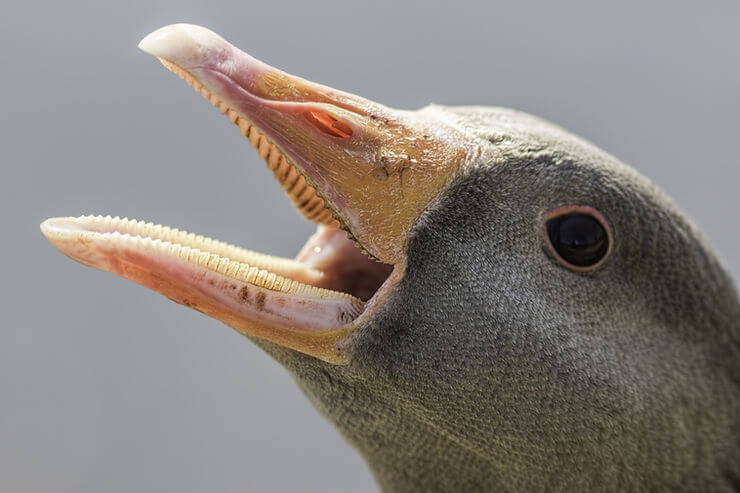
The Graylag Goose has a serrated bill which looks like a row of teeth.
Birds have beaks instead of teeth, so how do they tear and chew their food? They have a pouch like a stomach, called a gizzard, which crushes their food after it is swallowed whole. Many birds do have serrated edges, called tomia, along the edge of their beak to help them hold onto their food. Some, like the Graylag Goose and the Canada Goose, have such well- defined tomia that it looks like they really do have teeth. Unlike our teeth, which contain strong enamel, bird tomia are made out of hardened keratin, the same substance as their beaks. Keratin also happens to be the substance that makes up our fingernails, and it is not nearly as strong as our tooth enamel.
Check out the adorable baby birds in the picture below. What in the world? Do they have teeth? Nope. Most birds have tooth-like spines which help keep food in their mouths, but these spines are not made of enamel and dentin like mammal’s teeth and are not used for chewing.
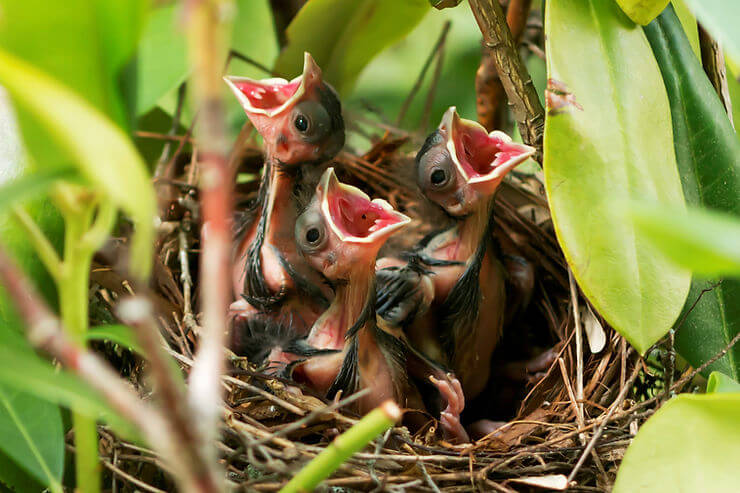
Many bird species have tooth-like spikes in their mouths to hold in their food.
Many sea animals do have teeth. Whales and dolphins are mammals like us, but their teeth are different than ours. Unlike ours, their teeth are not used for chewing and usually are all cone shaped and similar in size. Of course, there are exceptions like the narwhal with one tooth that develops as a horn. Orcas, dolphins and other toothed whales can have anywhere between one and 250 teeth.
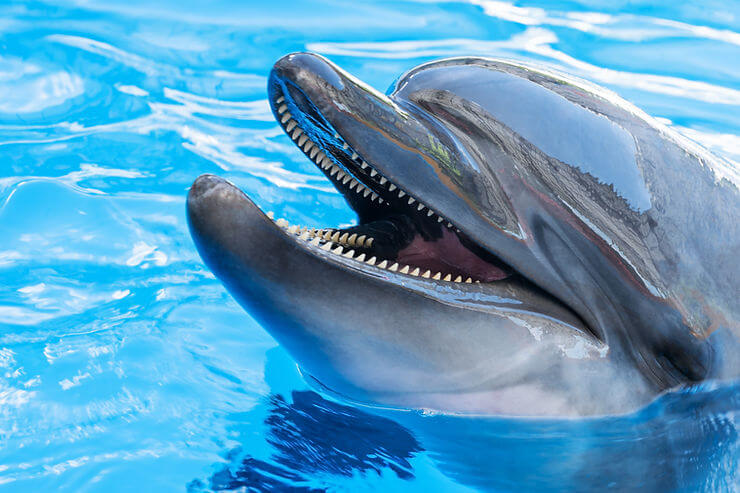
Toothed whales, like the dolphin, often have a row of cone shaped teeth.
Another type of ocean mammal is the baleen whale, which does not have teeth like most other mammals. Instead, they have a baleen plate which works like a sieve to catch the whale’s food. The baleen plate is made of keratin, the same substance as our fingernails and bird beaks.
Fish are not mammals, but can have incisors, canines and molars like we do, or something entirely different like a tooth plate for crushing food. Fish teeth can also grow in their jaws like a mammal, or in their lips, tongue and even in their throat! Sharks may be the scariest fish because of their very sharp teeth, but these teeth are just attached by ligaments to the jaw instead of being attached with roots. This means that their teeth fall out easily but, luckily for the shark, they can regrow them. Some sharks grow 35,000 teeth in their lifetime!
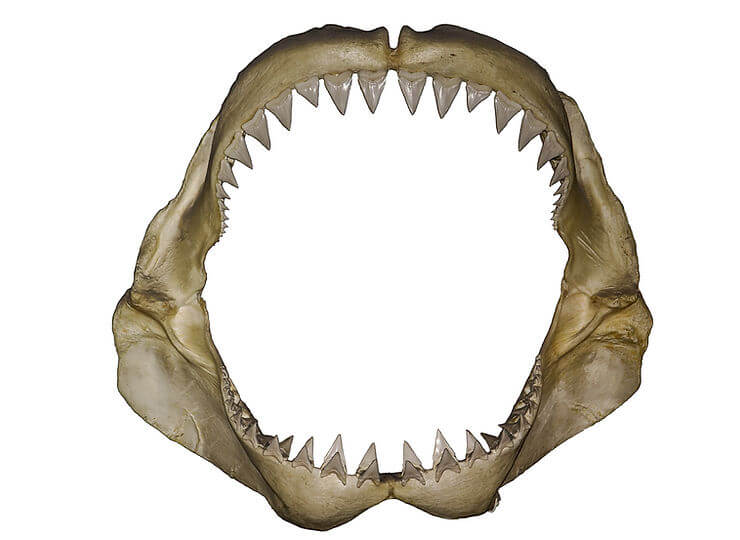
A shark’s jaw is made of cartilage, not bone, and its teeth are attached by ligaments.
Reptiles, like fish, may or may not have teeth, and their teeth can have extremely different shapes, attachments and uses. Turtles do not have teeth, but have a beak made of keratin like a bird. Crocodiles have teeth with strong roots like a mammal and one row of cone shaped teeth like toothed whales. However, unlike a whale, these teeth are constantly being replaced by new teeth which grow beneath the older teeth.
When you think of snake teeth you probably picture fangs like those of a rattlesnake, but most snakes have many nonvenomous teeth. Snake teeth grow in rows of sharp, spiky teeth with weak roots and are replaced throughout their life. Their function is to bring food into the mouth, and venomous snakes do have fangs to insert venom into their prey.
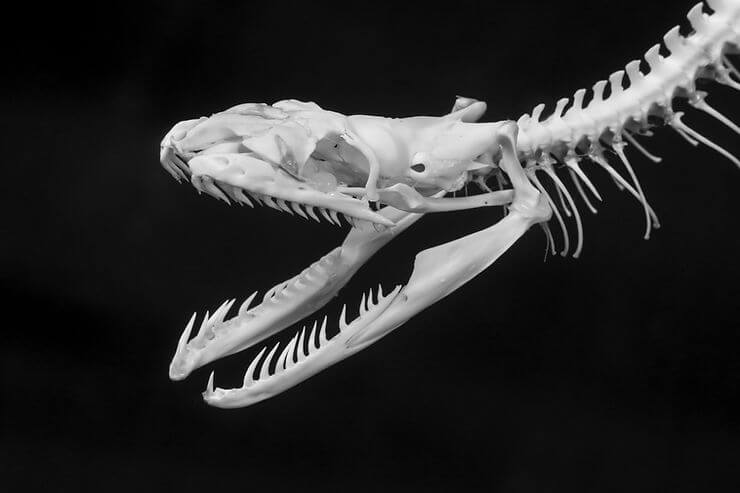
Most snake species have rows of teeth to help capture prey.
Like mammals, lizards can be carnivores, herbivores or omnivores, and they can also be insectivores, nectarivores, and molluscivores! This means that they also need a wide variety of teeth shapes and sizes to suit their species’ diet. Some lizards, such as chameleons, even use their tongue to help catch food. Komodo dragons, monitor lizards, iguanas and many other lizards produce venom which enters their prey through the lizard’s teeth.
Although mammals have incisors, canine teeth and molars which come in many different shapes and sizes, they only scratch the surface when it comes to variety in the animal kingdom. Human infants born with teeth, birds with teeth like serrations made of keratin, shark teeth attached with ligaments instead of roots, and snake teeth used to inject venom are just a few examples why teeth are incredibly amazing and diverse.
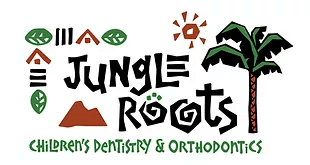
At Jungle Roots Children’s Dentistry & Orthodontics, we strive to provide the highest comprehensive pediatric and orthodontic dental care in a unique, fun-filled environment staffed by a team of caring, energetic professionals. We believe the establishment of a “dental home” at an early age is the key to a lifetime of positive visits to the dentist.
#1pediatricdentist#1pediatricdentistgilbert#1pediatricdentistphoenix#Arizona#BabyTeeth#BestDentistinPhoenix#brush#Canine#CanineTeeth#ChildrensDentistAhwatukee#ChildrensDentistGilbert#childrenteethgrinding#dentalappointment#dentalcare#dentist#DentistNearMe#dentistphoenix#DoWisdomTeethReallyNeedToBeRemoved#DrJohnCulp#ectopictooth#floss#HappyTeeth#HealthyLiving#HealthyTeeth#Howisapediatricdentistdifferentfromonewho#JungleRoots#JungleRootsAhwatukee#JungleRootsGilbert#KidsDentist#Molars#OralHealth#ortho#orthodontics#orthodonticspecialist#orthodonticsphoenix#PediatricDentist#PediatricDentistry#phoenix#SafeDentalSedation#teeth#teethgrinding#TheAnatomyofYourTeeth#Toothbrush#TopDentistGilbert#TopDentistPhoenix#Treatmentsprovidedbypediatricdentists#Whentovisitapediatricdentist#wisdomteeth#wisdomteethremoval
